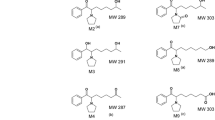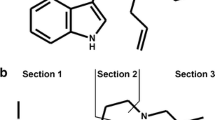Summary
The distribution, metabolism and elimination into the urine of (14C)-tetrahydronorharmane (THN) as well as of (14C)-6-hydroxy-tetrahydronorharmane (6-OH-THN) are investigated in female and male rats. Following intravenous injection of (14C)-THN radioactivity was detected in all organs examined, namely blood, brain, lung, adrenal gland, small intestine, fat tissue, kidney and liver.
In the brain the elimination half life of THN was calculated to be 1.8 h, the elimination half life of the radioactivity in the blood 6.24 h, and the accumulation half life in the urine 9.24 h. The elimination of 6-OH-THN into the urine is faster than that of THN.
At least four metabolites of (14C)-THN were found in the urine of female rats. Two different metabolic pathways are discussed, firstly, hydroxylation followed by conjugation with glucuronic and sulfuric acids and secondly, dehydrogenation, followed by oxygenation. In female rats only traces of the conjugated metabolites are hydrolysed by arylsulfatase, whereas in male rats approximately 2/5 are cleaved by this enzyme.
Pretreatment of male rats with 3-methylcholanthrene induced conjugation, whereas phenobarbital had no obvious effect on the pattern of metabolites. SKF 525 A and CFT 1201 both prevented almost completely the formation of conjugates from THN.
Similar content being viewed by others
References
Allen JRF, Beck O, Borg S, Skröder R (1980) Analysis of 1-methyl-1,2,3,4-tetrahydro-β carboline in human urine and cerebrospinal fluid by gas chromatography — mass spectrometry. Eur J Mass Spectrom Biomed Med Environ Res 1:171–177
Barker SA, Harrison GB, Brown GB, Christian ST (1979) Gaschromatographic/mass spectrometric evidence for the identification of 1,2,3,4-tetrahydro-β-carboline as in vivo constituent of rat brain. Biochem Biophys Res Commun 87:146–154
Barker SA, Monti JA, Christian ST (1980) Metabolism of the hallucinogen N,N-dimethyl-tryptamine in rat brain homogenates. Biochem Pharmacol 29:1049–1057
Greiner B, Rommelspacher H (1982) Urinary metabolites of tetrahydronorharmane in the rat. In: Bloom F, Barchas J, Sandler M, Usdin E (eds) Beta-carbolines and tetrahydroisoquinolines. Proceedings of a workshop held at the Salk Institute, La Jolla, CA, Dec 12 and 13, 1981. Alan R Liss, Inc, New York, pp 201–208
Ho BT, Estevez V, Fritchie GE, Tansey LW, Idänpään-Heikkilä J, McIsaac WM (1971) Metabolism of harmaline in rats. Biochem Pharmacol 20:1313–1319
Ho BT, Taylor D, Walker KE, McIsaac WM (1972) Metabolism of 6-methoxytetrahydro-β-carboline in rats. Xenobiotica 2:349–362
Honecker H, Rommelspacher H (1978) Tetrahydronorharmane (tetrahydro-β-carboline), a physiologically occurring compound of indole metabolism. Naunyn-Schmiedeberg's Arch Pharmacol 305:135–141
Kari J, Peura P, Airaksinen MM (1979) Mass fragmentographic determination of tetrahydro-β-carboline in human blood platelets and plasma. Med Biol 57:412–414
Klotz U (1979) Klinische Pharmakokinetik. Fischer. Stuttgart New York
McIsaac WM, Ho BT, Estevez V, Powers D (1967) Chromatography of β-carbolines. J Chromatogr 31:446–454
Mulder GJ, Hayen-Keulemans K, Sluiter NE (1975) UDP glucuronyl-transferase and phenolsulfotransferase from rat liver in vivo and in vitro. Characterization of conjugation and biliary excretion of harmol in vivo and in perfused rat liver. Biochem Pharmacol 24:103–107
Pang KS, Koster H, Halsema ICM, Scholtens E, Mulder GJ (1981) Aberrant pharmacokinetics of harmane in the perfused rat liver preparation: sulfate and glucuronide conjugations. J Pharmacol Exp Ther 219:134–140
Peura P, Kari I, Airaksinen MM (1980) Identification by selective ion monitoring of 1-methyl-1,2,3,4-tetrahydro-β-carboline in human platelets and plasma after ethanol intake. Biomed Mass Spectrom 7:553–555
Ritschel WA (1973) Angewandte Biopharmazie, chapter 8. Wissenschaftliche Verlagsgesellschaft, Stuttgart
Rommelspacher H, Honecker H, Barbey M, Meinke B (1979) 6-Hydroxy-tetrahydronorharmane (6-hydroxy-tetrahydro-β-carboline) a new active metabolite of indolealkylamines in man and rat. Naunyn-Schmiedeberg's Arch Pharmacol 310:35–42
Rommelspacher H, Strauss S, Lindemann J (1980) Excretion of tetrahydronorharmane and harmane into the urine of man and rat after a load with ethanol. FEBS Lett 109:209–212
Shoemaker DW, Cummins JT, Bidder TG, Evans M, Boettger HG (1980) Identification of harmane in the rat arcuate nucleus. Naunyn-Schmiedeberg's Arch Pharmacol 310:227–230
Slotkin TA, Di Stefano V, Au WYW (1970a) Blood levels and urinary excretion of harmine and its metabolites in man and rats. J Pharmacol Exp Ther 173:26–30
Slotkin TA, Di Stefano V (1970b) Urinary metabolites of harmine in the rat and their inhibition of monoamine oxidase. Biochem Pharmacol 19:125–131
Szara S, Rockland LH, Rosenthal D, Handlon JH (1966) Psychological effects and metabolism of N,N-dimethyltryptamine in man. Arch Gen Psychiat 15:320–329
Vejdélek ZJ, Trcka V, Protiva M (1961) Synthetic experiments in the group of hypotensive alkaloids. XXI. Chemistry of 1,2,3,4-tetrahydronorharmane-1-carboxylic acid and derivatives. J Med Pharm Chem 3:427–440
Villeneuve A, Sourkes TL (1966) Metabolism of harmaline and harmine in the rat. Rev Can Biol 25:231–239
Weisburger JH, Yamamoto RS, Williams GM, Grantham PH, Matsushina T, Weisburger EK (1972) On the sulfate ester of N-hydroxy-N-2-fluorenyl-acetamide as a key ultimate hepatocarcinogen in the rat. Can Res 32:491–500
Wengle B (1963) Studies on ester sulfates. 17. Sulfate conjugation in extracts of foctal and juvenile rat liver. Acta Soc Med Upsaliens 68:154–166
Zetler G, Singbartl G, Schlosser L (1972) Cerebral pharmacokinetics of tremor-producing harmala and iboga alkaloids. Pharmacology 7:237–248
Zetler G, Back G, Iven H (1974) Pharmacokinetics in the rat of the hallucinogenic alkaloids harmine and harmaline. Naunyn-Schmiedeberg's Arch Pharmacol 285:273–292
Author information
Authors and Affiliations
Rights and permissions
About this article
Cite this article
Greiner, B., Fähndrich, C., Strauss, S. et al. Pharmacokinetics of tetrahydronorharmane (tetrahydro-β-carboline) in rats. Naunyn-Schmiedeberg's Arch. Pharmacol. 322, 140–146 (1983). https://doi.org/10.1007/BF00512387
Received:
Accepted:
Issue Date:
DOI: https://doi.org/10.1007/BF00512387




